One of the most interesting things that you can do with your DNA is compare it to samples extracted from some of the most famous ancient human remains. In this post, I'll tell you how you can compare your personal DNA with DNA from ancient humans.
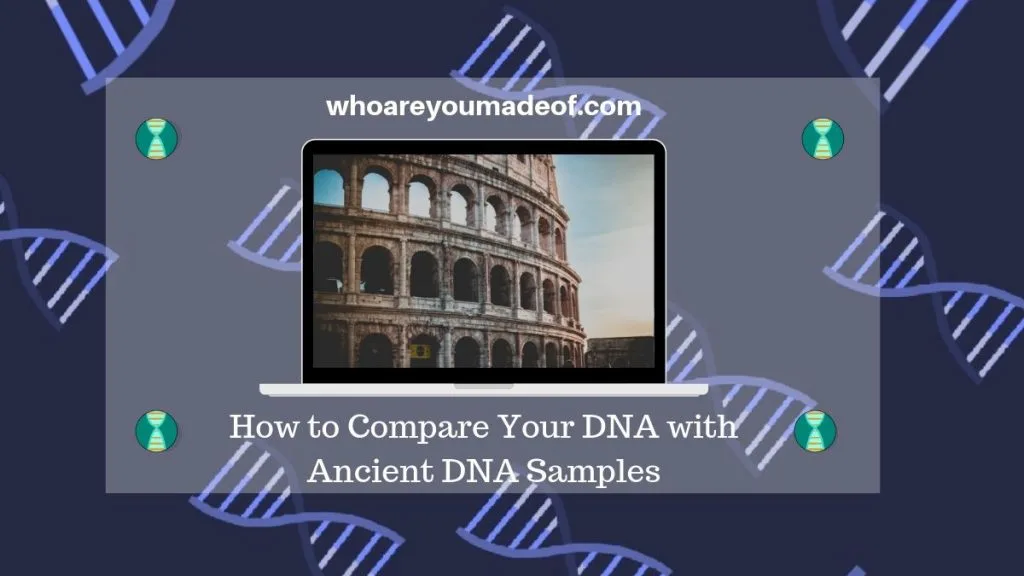
Do you want to know if you and the Kennewick Man shared a common ancestor? Curious to know how your DNA stacks up with samples taken from ancient remains in Siberia or Hungary?
Believe it or not, this is possible for anyone who has done a DNA test with any of the major DNA testing companies, and you could be doing it in a matter of minutes.
Can ancient DNA samples help you with family tree research?
Most of the DNA samples available online are many thousands of years old, and very little is known about the lives of the people from whom these ancient DNA samples were obtained. This means that comparing your DNA with information obtained from these samples will not be able to help you build your family tree.
Why would you want to spend time making these comparisons, then, if there is little actionable information to be obtained from the process? Even though you won't be able to identify a common ancestor shared between you and one of the ancient samples, you may notice that you'll share more tiny DNA segments, measured in centimorgans, with ancient inhabitants of continent where your ancestors lived.
This is kind of a cool idea to think that you and these ancient humans share a common origin, no matter how distant.
For example, I have absolutely no recent Native American ancestry, and have only scant evidence of Native American ancestors at least ten generations back in my family tree. A vast majority of my ancestors are from Eastern Europe, and I find that most of my shared DNA segments over a certain size are shared with ancient samples from countries located within Eastern and Central Europe.
My husband has primarily Native American ancestry, and he shares significantly sized DNA samples with ancient samples obtained in North America.
How to compare DNA with ancient DNA samples
In order to access information obtained from ancient DNA samples and compare them to yours, you need to do the following things:
- Take a DNA test with Ancestry DNA, My Heritage DNA, 23 and Me, or Family Tree DNA and have access to your results (haven't tested? Find out why Ancestry is the best test to determine your ancestry)
- Create an account at Gedmatch (learn about Gedmatch - it's free!)
- Upload your DNA to Gedmatch
Once you've done all three items, you can compare your DNA to ancient kits on Gedmatch.
How to use the Gedmatch Archaic DNA matches tool
To access the kit numbers for the "archaic" DNA matches, the first thing that you should do is run the Archaic DNA Matches tool using your Gedmatch kit number. This tool is located on your main Gedmatch dashboard under the "Analyze Your Data" section:
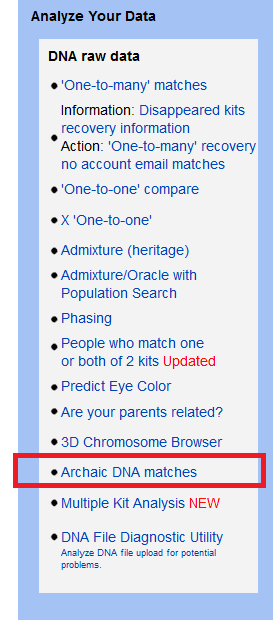
The second step is to enter your kit number and select the "Upper Segment Threshold Limit". This simply lets you choose the minimum segment size that you want the tool to display on the results.
If you pick the default, .5 centimorgans (cM), then you will see that you share lots of very, very small segments with almost every ancient DNA sample. This isn't very helpful, though, since at a .5 cM size, odds are exceedingly great that any match reported is completely coincidental.
Plus, at the .5 cM threshold, only 50 single nucleotide polymorphisms (SNPs) are analyzed, which also allows for tons of false segments to be reported.
Just so you can see what it would look like at this low threshold, in the image below you can see my own results. The yellow segments are matching regions, and the grey is where I don't match.
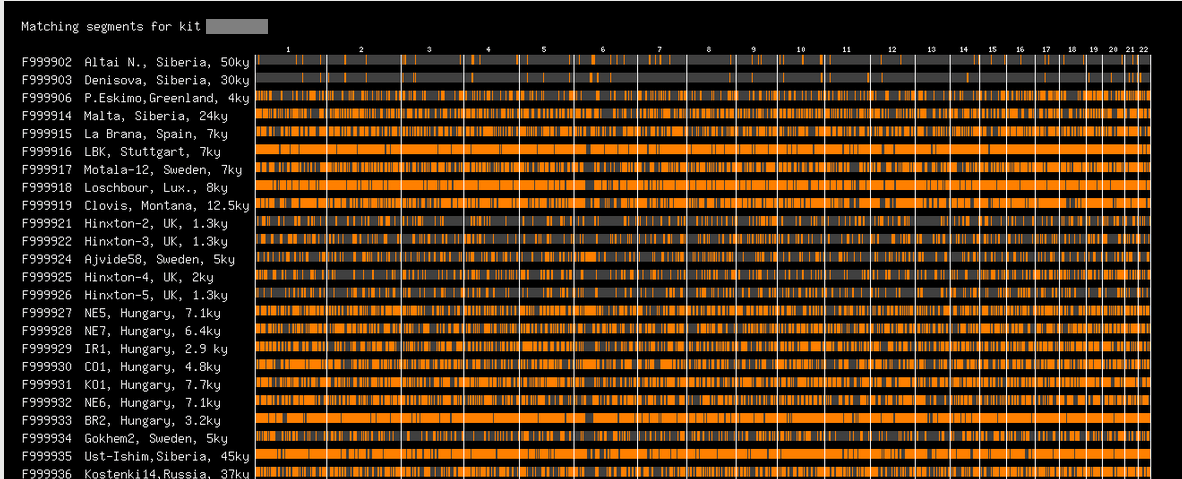
I recommend choosing a segment size that is 2 cM-4 cM. This is increases the likelihood that a segment match was actually passed down throughout the generations instead of being an "identical by state" match, or a coincidentally identical segment.
When I run the tool against my own DNA using a 4 cM threshold (and 400 SNPs - a much more reliable level), I can see that I still have a few matching segments. There is a good possibility that some of these segments still might be false (identical-by-state), but at least I have a few to work with.
In the next section, I'll explain how you might be able to tell whether or not these segments are real and imply a legitimate shared ancestry with these individuals.
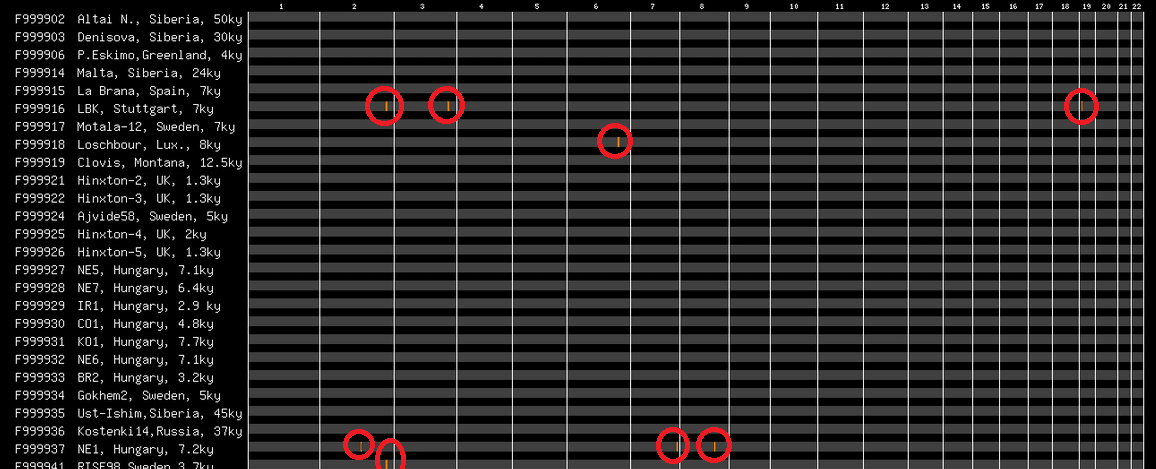
Run a Gedmatch One-to-One between your kit and the archaic kit
Before you can get an idea as to whether the segment you share with a kit is identical-by-descent (in other words: inherited), you'll have to use the Gedmatch One-to-One tool to compare your kits directly. This will tell you the exact location on each chromosome where your matching segment, or segments, are located.
As an example to illustrate this, I decided to pick an ancient kit from a place where I know my ancestors lived: Germany. I am going to run the One-to-One tool using the Stuttgart kit #F999916.
This individual who was likely a part of the early European Linear Pottery Culture and who died around 7,000 years ago. According to other tools available on Gedmatch, there is no evidence that his parents were closely related, suggesting that his parents came from separate communities - and he possibly had brown eyes.
I'm going to use the tool, but I am going to make sure to remember to set the threshold to the same one that I chose for the Archaic DNA Matches tool. In this case it was 4 cMs and 400 SNPs.
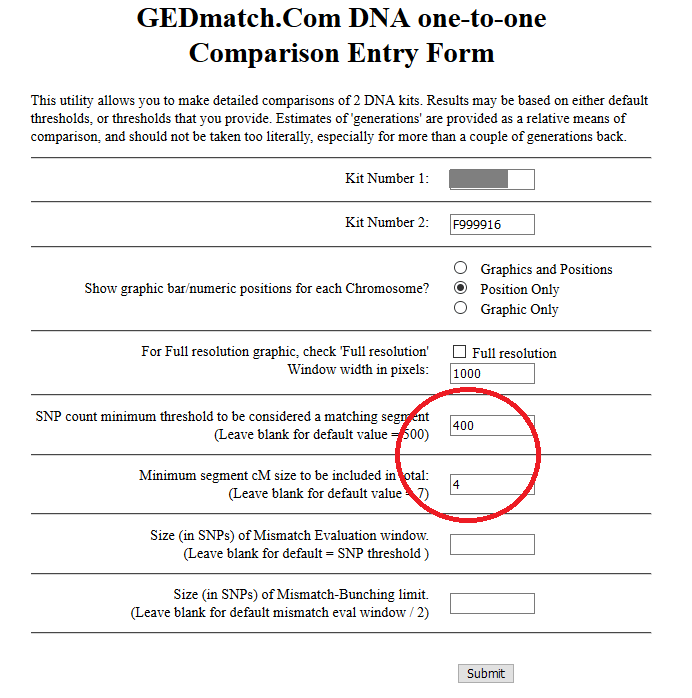
To my surprise, I got a matching segment. According to Gedmatch, I share a 5.0 cM segment with this 7,000 year old ancient German individual. I'm encouraged by the high number of SNPs that were compared, too - 635!
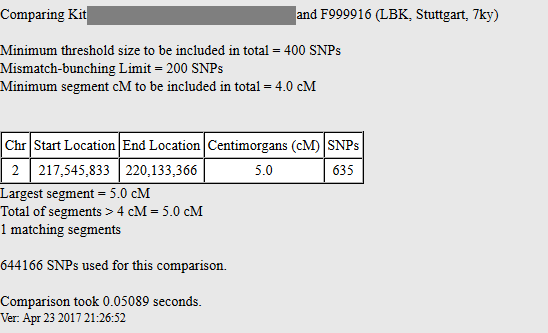
How to know whether the small segment with archaic DNA kit is false or legitimate?
It's not easy to know with absolute certainly whether a DNA segment is inherited or identical-by-state, but there is one way to get a fairly good idea. I'm lucky in the sense that both of my parents have done DNA tests and their DNA is available on Gedmatch for analysis and comparison.
For this example, I was able to compare the Stuttgart sample with both of my parents' DNA.
What am I looking for? I'm going to do a One-to-One comparison between each of them and the Stuttgart kit #F999916 in order to see if either of them share a matching segment on this same chromosome.
If you do this with your DNA, make sure to set your cM and SNP threshold to the same level as you did when you ran the comparison using your kit number.
My father's results - no shared DNA segments found!
My father shares no DNA with this Stuttgart kit, at least at this threshold level.
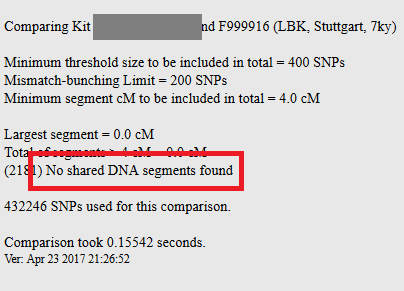
My mothers' results - overlapping segment at the same location where mine is!
My mother's kit does share a segment on this same location. You might notice that the segment that my mother shares starts almost exactly where mine does on Chromosome 2. My matching segment seems to go a little further, but I'm not sure that this is significant - especially for this use.
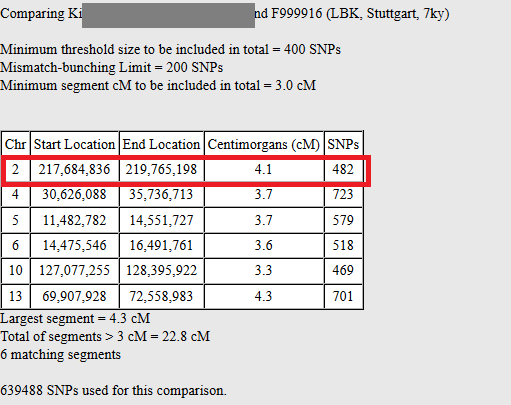
So what does it mean if I have a legitimate matching DNA segment with an archaic DNA sample?
As you can tell from the results that I displayed above, there is a good chance that this person whose DNA was analyzed from the Linear Pottery Culture and I share a common ancestor from many, many generations ago. How many generations? Using the average of 12 generations every 350 years, this person may have lived 240 generations ago - or even more.
To me, this is very interesting. My mom's family is primarily German and Eastern European, and this makes me wonder how long her family really has been living in the area. A long time, it seems!
Ancient history coming to life! Absolutely fascinating.
Conclusion
By playing around with Gedmatch and these archaic kits, you will learn a lot about your DNA and about how to understand the results of the tools that Gedmatch offers.
I hope you enjoyed this post, and that you give the Archaic DNA Matches tool a try. If you do, or if you already have, I would love to hear from you in the discussion below about what you learned.
Thanks for stopping by!

Rene D
Monday 5th of February 2024
I am just now trying to dig more into this. I am unable to use the 1to1 with the ancient dna sample kits. Do you have any suggestions on this? Thank you.
Liz Davenport
Tuesday 24th of June 2025
@Rene D, just came across your inquiry. Probably the best that you can do, when trying to compare your kit to an ancient DNA sample, is to set the Minimum Segment cM size at 3.0 cM, which is the lowest you can choose, after you enter your kit # and the kit # of the ancient DNA sample you wish to compare to.
Lance Holt
Sunday 5th of September 2021
I would like to know how you learn more about the excavation to the archaeological remains you match with? I would like to take my matches a step further and learn more about the excavation. What steps can I take to track down the location of the archaeological site where the remains were discovered?
R Fitz
Thursday 1st of September 2022
@Lance Holt, ... Google..
dmiangoys
Tuesday 13th of April 2021
it depends of the DNA kit some company , the results come up different , in my cade i get a better result with my heritage than with ftdna